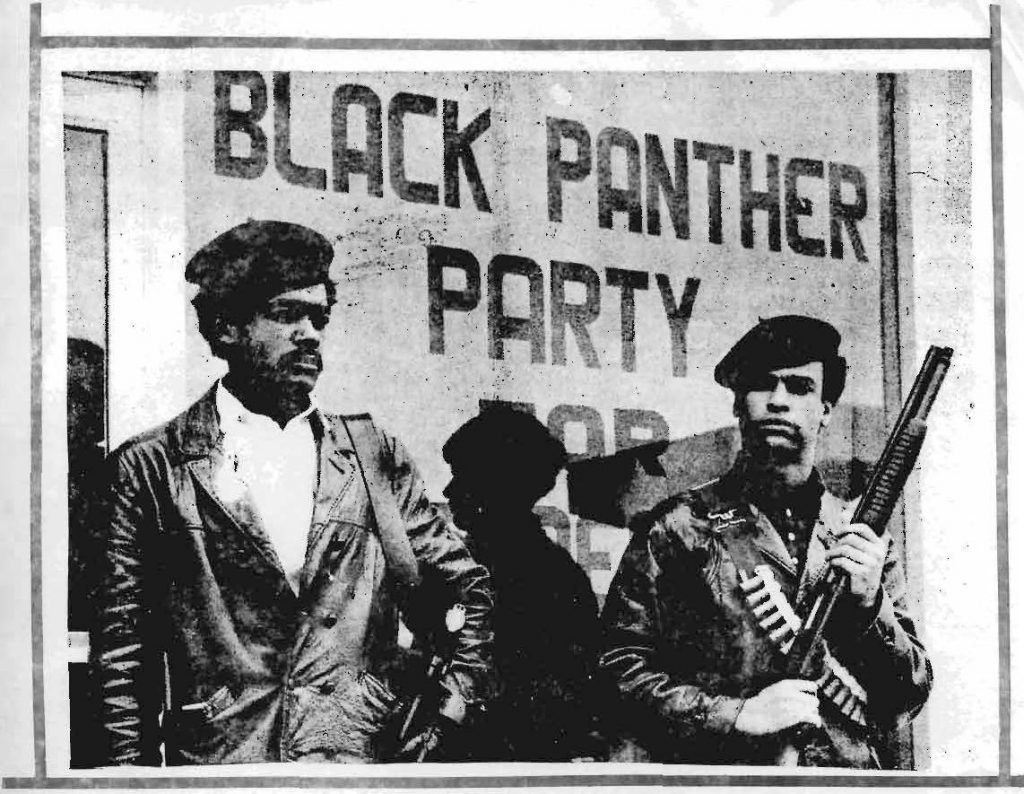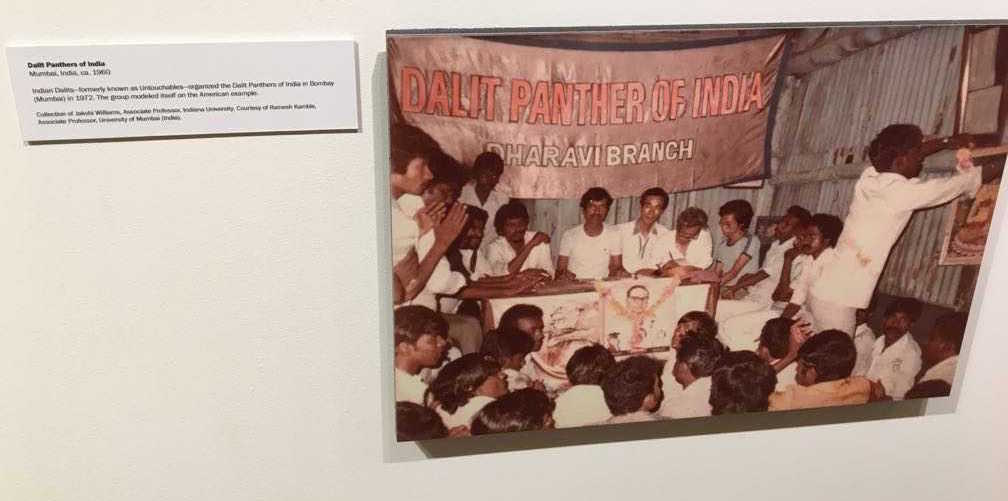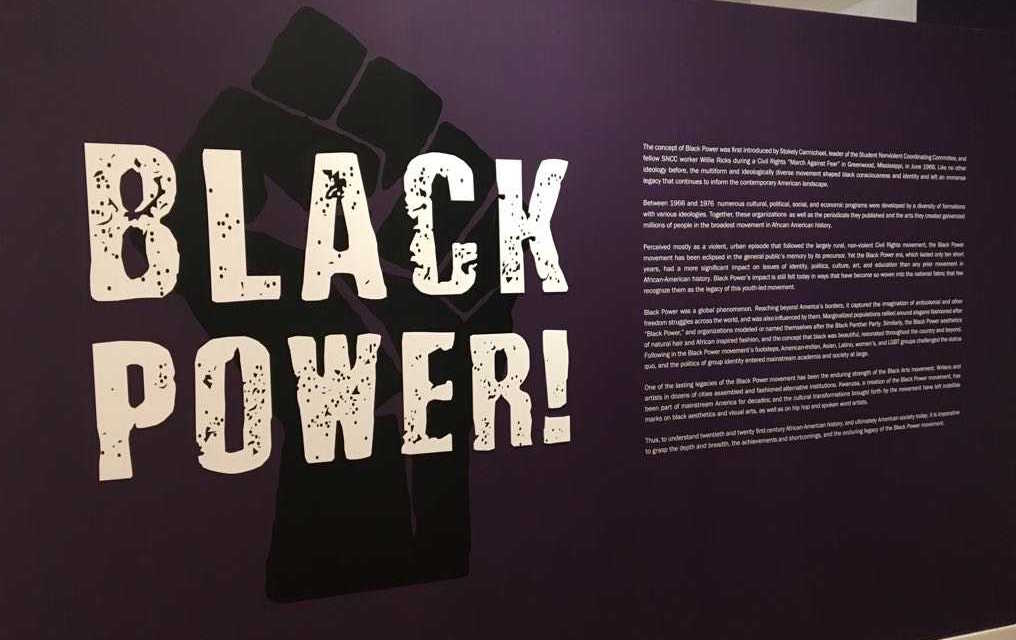
The Dalit Panthers and the Black Panthers – Brief historical backgrounds of two revolutionary movements
Author – Umang Kumar
In 2017, a premier institute for African-American history and culture based in New York, the Schomburg Center, held an exhibition titled “Black Power.” The exhibition documented various aspects of a movement in black history in the US which might be called the Black Power phase. As part of the exhibition, there were some example exhibits from movements around the world which have been influenced by manifestations of the Black Power movement in the US. The Dalit Panthers were accorded pride of place in the exhibition narrative as one such example.
The Dalit Panthers modelled themselves after the Black Panther Party in the US, more specifically the one which was initially called the Black Panther Party for Self Defense, formed in the city of Oakland, California in 1966.

“The Dalit Panthers exhibit at the Black Power exhibition in New York” – Image attribution/courtesy – Umang Kumar
As we look into brief histories of both the parties, continents away, one in the US and one in India, it will be valuable to notice several of the common aims, aspirations and visions.
The Black Panther Party (BPP) of Oakland was actually one of the several such parties that were constituted in the US in the 1960s. They took their inspiration from the “original” Black Panther Party which was formed in the southern US state of Alabama. There, in a subdivision called Lowndes County, an organization sprang up that wanted to politically empower the black community by urging them to register to vote.
The 15th Amendment to the US Constitution in 1870 allowed for voting rights to every citizen, irrespective of race and color. Yet, many southern US states soon devised impediments like literacy tests and taxes to dissuade black voters. This caused suppression of the voting rights of the black voters.
The American Civil Rights movement, whose public face was Martin Luther King Jr. from 1957, was deeply invested in the issue of voter registration. King was part of an organization called the Southern Christian Leadership Council (SCLC).
In 1960, renowned activist Ella Baker, who was an Executive Secretary at SCLC, organized a conference of some student activists (who had earlier boycotted segregated lunch counters) and this led to the founding of a youth-led organization called Student Nonviolent Coordination Committee (SNCC). SNCC activists pursued the work of voter registration in the rural south of the US, including in Lowndes County, Alabama.
One of SNCC’s leaders, Stokely Carmichael helped with the founding of a local political party in Lowndes, originally called Lowndes County Freedom Organization. It was this party, whose symbol was a black panther, which was renamed the Black Panther Party (BPP) of Lowndes.
As explained by one of the members of this party regarding the symbol of a black panther,
“this black panther is a vicious animal as you know. He never bothers anything, but when you start pushing him, he moves backwards, backwards, and backwards into his corner, and then he comes out to destroy everything that’s before him.
Negroes in Lowndes County have been pushed back through the years. We have been deprived of our rights to speak, to move, and to do whatever we want to do at all times. And now we are going to start moving…”

Black Power exhibition in New York 2017 – Image attribution/courtesy – Umang Kumar
The BPP in Lowndes positioned itself as the third party, separate from the mainstream Democratic and Republican parties. Also, Carmichael espoused a slightly more militant path to civil rights than the SCLC. As he said in an interview, the Lowndes party was out to wrest power: “What [Martin Luther] King has working for him is a moral force, but we’re building a force to take power…We’re not a protest movement. We’re out to take power legally…”
On Jun 17 1966, at a rally in the state of Mississippi, Carmichael raised the call for Black Power: “We have been saying freedom for six years and we ain’t got nothin. What we gonna start saying now is BLACK POWER!”
Such an articulation for Black Power had been made before, but Carmichael’s example came at a time when the atmosphere was very charged. The 60s were a socially and politically volatile time in the US with several race protests and a general disillusionment with the integrationist, gradual strategy of the Civil Rights movement.
This renewed call for Black Power was heard throughout the US and it resonated with a lot of people and communities. In Oct 1966, a conference on Black Power was held in University of California (Berkeley) on the US west coast, not far from Oakland, in which Carmichael was one of the speakers.
The Black Panther Party in Oakland CA, which took inspiration from the call for Black Power and the Black Panther Party in Lowndes, came into existence that same year, 1966.
From this point on, it was the tactics, actions and stance of this Black Panther Party that caught the imagination of the US and, soon the world. Started by two students of Merritt College in Oakland, Bobby Seal and Huey Newton, the BPP gradually grew in the organization, reach and influence.
They famously came out with their Ten Point Program, which had prominent sections called “What We Want” and “What We Believe.” Among the ‘wants’ were demands for Freedom of self-determination, Employment, Housing, Education, end to police brutality, and “Land, Bread, Justice and Peace.”
As they grew they had offices and branches in different parts of the US and they evolved a multi-level organizational structure. Their success and their defiance brought down the state’s reprisals against them as one after another several of their top members were assassinated. Their organization was the target of relentless surveillance also.
What the BPP is also remembered for, in addition to its programs for overt black power, are what are known as its “Survival Programs,” like free breakfast for children, free screening for sickle-cell anemia and free Liberation Schools.
Crucial to the story of the Black Panther Party that captivated the imagination of so many oppressed people around the world was certainly their defiance and their courage – but also the way they seemed to express a vision of the world; how they organized themselves; and how they advocated for political power. The roots of the Black Power movement in the voter registration struggles cemented the idea that the power that really mattered was political power.
The other factor was the politicization and the firebrand energy of the youth as represented by groups like SNCC and then later by the BPP in Oakland. Huey Newton was 24 when they formed the party. Another radical member, Fred Hampton who headed the Chicago chapter of BPP, was 20 when he joined.
It was the same energy which the recent Movement for Black Lives has been exhibiting. While the US still has several well-respected African-American organizations – the National Association for the Advancement of Colored People (NAACP), founded in 1907 is still around – it is the newer outfits with young activists who are leading the charge today after the killing of George Floyd.
We can appreciate Dr. B.R. Ambedkar’s foresight and tenacity in seeking special voting privileges for the marginalized. He knew how political representation and the process of elections work, even in so-called democracies, and he tried to secure every safeguard he could, when he stated that “the majority is not prepared to allow the minorities to share political power.”
The Dalit Panthers, which was formed in 1972 in Mumbai, drew its inspiration from the Black Panthers. As Raja Dhale, one of the core members of the Dalit Panthers, stated in interviews [here and here], he was introduced to the Black Panthers through international news magazines like Time and Newsweek: “Around the same time, in Time, there was a lot of coverage of the shoot-out episodes involving Black Panthers, the strict measures the police took against them, the deaths of Panthers and their trials in the court. I started following Newsweek too. That was probably the year 1968, or maybe after that. The Panthers entered my conscience, and they came there to stay.” J.V. Pawar, another core member of Dalit Panthers, named his daughter Angela after the scholar-activist and BPP member, Angela Davis.
The Dalit Panther Party emerged out of the brainstorming sessions in which several poets and writers participated at different times. Prominent literary figures like Namdeo Dhasal, Arjun Dangle, Raja Dhale, JV Pawar and Baburao Bagul were associated with the party.
Like the Black Panther Party, there was the dissatisfaction of the Dalit youth that laid the foundations of the Dalit Panthers. Youth groups like Yuvak Aghadi, Yuvak Kranti Dal etc that had been organizing rallies and also fact-finding missions to areas which witnessed atrocities against Dalits in Maharashtra. Raja Dhale had been part of Yuvak Aghadi before he joined the Dalit Panthers.
In 1970, a report, the Eliya Perumal report on the state of oppression and atrocities against Dalits was made public. Its findings were shocking and it caused great agitation in the Dalit community.
Soon after the Dalit Panthers’ formation, Dhale’s writeup in the Sadhana magazine in 1972 titled “Kala Svatantrya Din” (Black Independence Day), on the occasion of India’s 25th Independence Day, led to a wave of denouncements from the establishment. In his piece Dhale had strongly criticized India’s so-called independence when Dalit faced continuing atrocities. The Panthers held their ground against protests relating to Dhale’s piece by counter-protesting and even won supporters in Pune, when Sadhana was based.
The Dalit Panthers were also formed as a protest against the degeneration in the older party representing Dalits, the Republican Party of India (RPI). The RPI had been founded by Dr. Ambedkar but soon after his passing, it split into several factions and lost touch with ground realities.
As J.V. Pawar states in his book, “Dalit Panthers: An Authoritative History,” RPI members did not react strongly to the revelations in the Elaya Perumal report. “Veteran Dalit leaders scattered among various factions of RPI were unmoved, but young writers and poets wanted the government to take action,” he states.
The Dalit Panthers crossed paths not just with the RPI but with several other political formations, including the Congress, the Shiv Sena, various Socialists, Lohiaites and Communists.
The Dalit Panthers stayed away from politics, boycotting the 1973 Mumbai Municipal elections, for instance (The Liberation Panthers in Tamil Nadu (DPI or Dalit Panthers Iyakkam), drawing inspiration from the Dalit Pathers of Maharashtra, however, entered political fray, as shown by Hugo Gorringe in his book “Untouchable Citizens”). As they crafted a manifesto, they stressed on the social interventions that they sought to effect. This they carried out with great success, often traveling to different parts of Mumbai and rural Maharashtra to take the side of those wronged.
They interceded in a wide variety of cases such as violence against women and in issues of land disputes. They also took on the symbols of the Hindu religious system, such as the burning of the Gita and debating the Shankaracharya of Puri (who defended the Manusmriti).
The might of the state reprisal was relentless against them as each public action of protest resulted in Dalit Panther activists being arrested and also enmeshed in legal procedures. Many of the top leadership had several cases against them.
Internal differences and the strains of managing a rapidly growing organization also began telling on them and that proved to be their gradual undoing.
While both the Black Panthers in the US and the Dalit Panthers in India were short lived expressions of radical organizing and protest, they shook up the status quo and inspired a lot of youth. The BPP leadership was hunted down very ruthlessly and many of them had to leave the US for safer harbors. Quite a number of them were jailed where they still are till the present day – people like Mumia Abu-Jamaal and Romaine “Chip” Fitzgerald.
Both the Panthers, in the US and India, raised fundamental and critical questions about the meaning of freedom, liberty and justice for the marginalized – the blacks in the US and the Dalits in India. What they were fighting against then are still matters of life and death for the black and Dalit communities today, as is evident from the continual incidents of police violence, deadly vigilante justice, atrocities over assertions of identity and denial of equal rights.
Hearteningly, the solidarities felt decades ago between the struggles between the black and the Ambedkarite people have been ongoing in one way or another. The brutal killing of George Floyd – and also the murders of young women and men in just the last few months, like those of Ahmaud Arbery, Breonna Taylor and Rayshard Brooks – has rekindled the global solidarities.
Various Ambedkarites have expressed their support for the struggles of the African-Americans once again. There is renewed thinking of connecting the two struggles, to draw on each other’s experiences and resources, and for strengthening the impact of strategies. The panthers cannot be pushed back to the wall once again.
—




+ There are no comments
Add yours